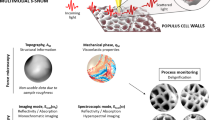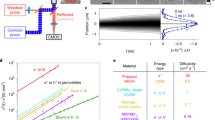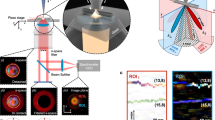Abstract
The non-destructive, simultaneous chemical and physical characterization of materials at the nanoscale is an essential and highly sought-after capability. However, a combination of limitations imposed by Abbe diffraction, diffuse scattering, unknown subsurface, electromagnetic fluctuations and Brownian noise, for example, have made achieving this goal challenging. Here, we report a hybrid approach for nanoscale material characterization based on generalized nanomechanical force microscopy in conjunction with infrared photoacoustic spectroscopy. As an application, we tackle the outstanding problem of spatially and spectrally resolving plant cell walls. Nanoscale characterization of plant cell walls and the effect of complex phenotype treatments on biomass are challenging but necessary in the search for sustainable and renewable bioenergy. We present results that reveal both the morphological and compositional substructures of the cell walls. The measured biomolecular traits are in agreement with the lower-resolution chemical maps obtained with infrared and confocal Raman micro-spectroscopies of the same samples. These results should prove relevant in other fields such as cancer research, nanotoxicity, and energy storage and production, where morphological, chemical and subsurface studies of nanocomposites, nanoparticle uptake by cells and nanoscale quality control are in demand.
This is a preview of subscription content, access via your institution
Access options
Subscribe to this journal
Receive 12 print issues and online access
$259.00 per year
only $21.58 per issue
Buy this article
- Purchase on Springer Link
- Instant access to full article PDF
Prices may be subject to local taxes which are calculated during checkout





Similar content being viewed by others

References
Garcia, R. & Herruzo, E. T. The emergence of multifrequency force microscopy. Nature Nanotech. 7, 217–226 (2012).
Tetard, L., Passian, A. & Thundat, T. New modes for subsurface atomic force microscopy through nanomechanical coupling. Nature Nanotech. 5, 105–109 (2010).
Marquardt, F. & Girvin, S. Optomechanics. Physics 2, 40 (2009).
Lucas, M. & Riedo, E. Combining scanning probe microscopy with optical spectroscopy for applications in biology and materials science. Rev. Sci. Instrum. 83, 061101 (2012).
Dazzi, A., Prazeres, R., Glotin, F. & Ortega, J. M. Local infrared microspectroscopy with subwavelength spatial resolution with an atomic force microscope tip used as a photothermal sensor. Opt. Lett. 30, 2388–2390 (2005).
García, R., Magerle, R. & Perez, R. Nanoscale compositional mapping with gentle forces. Nature Mater. 6, 405–411 (2007).
Herruzo, E. T., Perrino, A. & García, R. Fast nanomechanical spectroscopy of soft matter. Nature Commun. 5, 3126 (2014).
Davison, B. H. The increasing importance and capabilities of biomass characterization. Ind. Biotechnol. 8, 189–190 (2012).
Haisch, C. Photoacoustic spectroscopy for analytical measurements. Meas. Sci. Technol. 23, 012001 (2012).
Foston, M. & Ragauskas, A. J. Biomass characterization: recent progress in understanding biomass recalcitrance. Ind. Biotechnol. 8, 191–208 (2012).
Kac˘uráková, M., Capek, P., Sasinková, V., Wellner, N. & Ebringerová, A. FT-IR study of plant cell wall model compounds: pectic polysaccharides and hemicelluloses. Carbohydr. Pol. 43, 195–203 (2000).
Studer, M. H. et al. Lignin content in natural Populus variants affects sugar release. Proc. Natl Acad. Sci. USA 108, 6300–6305 (2011).
Galazka, J. M. & Cate, J. H. D. Improving the bioconversion of plant biomass to biofuels: a multidisciplinary approach. Energy Environ. Sci. 4, 3329 (2011).
Lynd, L. R. et al. How biotech can transform biofuels. Nature Biotechnol. 26, 169–172 (2008).
Davison, B. H., Keller, M. & Fowler, V. S. The goals and research of the BioEnergy Sciences Center (BESC): developing cost-effective and sustainable means of producing biofuels by overcoming biomass recalcitrance. Bioenerg. Res. 2, 177–178 (2009).
Ding, S.-Y. et al. How does plant cell wall nanoscale architecture correlated with enzymatic digestibility? Science 338, 1055–1060 (2012).
Fernandes, A. N. et al. Nanostructure of cellulose microfibrils in spruce wood. Proc. Natl Acad. Sci. USA 108, E1195–E1203 (2011).
Himmel, M. E. Biomass Recalcitrance (Blackwell, 2008).
Fahlen, J. & Salmen, L. Pore and matrix distribution in the fiber wall revealed by atomic force microscopy and image analysis. Biomacromolecules 6, 433–438 (2005).
Grethlein, H. E. The effect of pore size distribution on the rate of enzymatic hydrolysis of cellulosic substrates. Nature Biotechnol. 3, 155–160 (1985).
Jung, S., Foston, M., Sullards, M. C. & Ragauskas, A. J. Surface characterization of dilute acid pretreated Populus deltoides by ToF-SIMS. Energy & Fuels 24, 1347–1357 (2010).
Tetard, L. et al. Virtual resonance and frequency difference generation by van der Waals interaction. Phys. Rev. Lett. 106, 180801 (2011).
Kalluri, U. C. & Keller, M. Bioenergy research: a new paradigm in multidisciplinary research. J. R. Soc. Interface 7, 1391–1401 (2010).
Sannigrahi, P., Ragauskas, A. & Tuskan, G. A. Poplar as a feedstock for biofuels: a review of compositional characteristics. Biofuels Bioprod. Bioref. 4, 209–226 (2010).
Schenzel, K., Fischer, S. & Brendler, E. New method for determining the degree of cellulose I crystallinity by means of FT Raman spectroscopy. Cellulose 12, 223–231 (2005).
Tetard, L. et al. Imaging nanoparticles in cells by nanomechanical holography. Nature Nanotech. 3, 501–505 (2008).
Plodinec, M. et al. The nanomechanical signature of breast cancer. Nature Nanotech. 7, 757–765 (2012).
Coffey, D. C., Reid, O. G. & Ginger, D. S. Imaging local photocurrents in polymer/fullerene solar cells with photoconductive atomic force microscopy. Nano Lett. 7, 738–744 (2007).
Leopold, J., Gunther, H. & Leopold, R. New developments in fast 3D-surface quality control. Measurement 33, 179–187 (2003).
Solar, M. I. & Buehler, M. J. Composite materials: taking a leaf from nature's book. Nature Nanotech. 7, 417–419 (2012).
Sato, Y. et al. Strong coupling between distant photonic nanocavities and its dynamic control. Nature Photon. 6, 56–61 (2012).
Stinaff, E. A. et al. Optical signatures of coupled quantum dots. Science 311, 636–639 (2006).
Acknowledgements
This work was sponsored by the BioEnergy Science Center (BESC) of the Oak Ridge National Laboratory (ORNL). L.T. acknowledges partial support from ORNL's Wigner Fellowship Program. The authors thank the BESC scientists S. Jung and A. Ragauskas at Georgia Institute of Technology for providing the samples and M. Davis and R. Sykes at the National Renewable Energy Laboratory (NREL) for providing the Populus stems that were used for cross-sectioning. BESC is a US Department of Energy (DOE) Bioenergy Research Center supported by the Office of Biological and Environmental Research in the DOE Office of Science. ORNL is managed by UT-Battelle, LLC, for the US DOE under contract DE-AC05-00OR22725.
Author information
Authors and Affiliations
Contributions
All authors contributed to the manuscript. A.P. and R.H.F. performed the revisions, new measurements and data analysis. B.H.D. provided plant biological expertise.
Corresponding author
Ethics declarations
Competing interests
The authors declare no competing financial interests.
Supplementary information
Supplementary information
Supplementary information (PDF 24005 kb)
Rights and permissions
About this article
Cite this article
Tetard, L., Passian, A., Farahi, R. et al. Opto-nanomechanical spectroscopic material characterization. Nature Nanotech 10, 870–877 (2015). https://doi.org/10.1038/nnano.2015.168
Received:
Accepted:
Published:
Issue Date:
DOI: https://doi.org/10.1038/nnano.2015.168
This article is cited by
-
In situ plant materials hyperspectral imaging by multimodal scattering near-field optical microscopy
Communications Materials (2021)
-
Nanoscale chemical imaging of individual chemotherapeutic cytarabine-loaded liposomal nanocarriers
Nano Research (2019)
-
Modified cantilever arrays improve sensitivity and reproducibility of nanomechanical sensing in living cells
Communications Biology (2018)
-
Surface mediated cooperative interactions of drugs enhance mechanical forces for antibiotic action
Scientific Reports (2017)
-
Plasticity, elasticity, and adhesion energy of plant cell walls: nanometrology of lignin loss using atomic force microscopy
Scientific Reports (2017)


